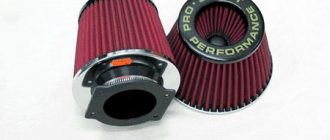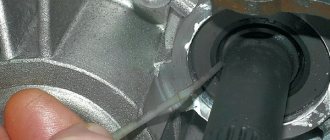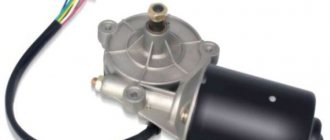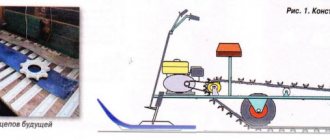Engine 2112 characteristics
Years of production - (1997 - 2004) Cylinder block material - cast iron Power system - injector Type - in-line Number of cylinders - 4 Valves per cylinder - 4 Piston stroke - 71mm Cylinder diameter - 82mm Compression ratio - 10.5 Engine displacement 2112 - 1499 cm cube
Engine power 2112 – 93 hp. /5600 rpm Torque - 128 Nm / 3700 rpm Fuel - AI95 Fuel consumption - city 8.8 l. | track 5.5 l. | mixed 7.2 l/100 km Oil consumption - 50 g/1000 km Weight of the VAZ 2112 engine - 127 kg Overall dimensions of the 2112 engine (LxWxH), mm - Oil for the VAZ 2112 engine: 5W-30 5W-40 10W-40 15W40 How much oil in engine 2112: 3.5 l. When replacing, pour 3.2 liters. Resource: 1. According to the plant – 150 thousand km 2. In practice – 250 thousand km
TUNING Potential – 400+ hp. Without loss of resource - up to 120 hp.
Motor VAZ 2103
Since the late 70s, cars produced on special order, for example, for some police units, have had a completely new power unit, which has different technical characteristics, unlike other VAZ engines.
It was installed both on the later Kopeykas and on its successors - export 2102, 2103, 2107 and later on 2121, 21053.
These VAZ 2103 engines have become an absolute novelty (plural, but before and after everything is singular). Thanks to its dynamics, they allowed it to accelerate to 100 km/h in less than 17 seconds.
Such indicators became possible due to a number of changes:
- The volume increased to 1500 cm3;
- The piston stroke increased by 14 mm;
- maximum power became 77 hp. With. ;
- torque was determined for the first time. On this type of VAZ engine it became 104/3400.
The cylinder block is made of a special cast iron alloy, the cylinder head is made of aluminum. These rules were mandatory for all types of engines, and the fundamental difference was in the diameter of the cylinders. If for units 21011, 2105 and 2106 it was within 79 mm, then in 2103 it became 76 mm.
Another positive feature of this model is the ability to install crankshaft 21213, which has identical parameters, but improved technical characteristics of the VAZ engine.
In addition, the 2103 can be equipped with both classic and contactless ignition. Rebuilding the engine was not particularly difficult for specialists, and the availability of spare parts in terms of availability and pricing did not force the owner to search for places and means of purchase for a long time.
Malfunctions and repairs of the VAZ 2112 engine
The VAZ 2112 (21103) engine is a qualitative evolution of the VAZ 2111 engine, but with 16 valves instead of 8 and gave rise to a series of VAZ gears that are produced to this day, already in the form of a prior engine. The main differences between the 2112 engine and the 2111 are the use of 4 valves per cylinder, 2 camshafts, this allows the engine to supply more fuel-air mixture to the combustion chamber at a time and quickly remove exhaust gases to the exhaust channel. Up to 3 thousand rpm, the engines operate approximately the same; after 3 thousand, 16V becomes much more dynamic. At the same time, fuel consumption is lower than on the 8 valve 2111. Engine VAZ 2112 1.5 liters. injection in-line 4-cylinder with an overhead camshaft, the gas distribution mechanism is belt driven. Cylinder block 2112, the same as on 21083, but with modified mounts under the cylinder head and additional oil channels for the main bearings, the VAZ 2112 engine number is stamped on the block under the thermostat. The normal operating temperature of the 2112 engine is 90 degrees. The service life of the 2112 engine, according to the manufacturer’s data, is 150 thousand km; in practice, the engines run more than 250 thousand km. The other side of the coin is the VAZ 2112 engine, when the timing belt breaks, the valve bends. The problem is solved by installing pistons from a 124 engine, but we will inevitably lose a few horsepower. If you do not want to lose power, you need to constantly monitor the condition of the belt. To do this, we listen to the sounds coming from the drive; the rollers usually begin to squeak when cold, then rustle, and then collapse. The pump begins to leak (the belt will be covered in coolant). The shaft seals are leaking (the belt is covered in oil). The shafts wear out - the belt begins to slide to the side and rub against the roller flange (grinding when cold). The belt can also slip due to crooked rollers. Problems and malfunctions: the 2112 engine is throttling or adjusting - measure the compression, is it normal? Check the ignition module, high-voltage wires and spark plugs, these are the main problems in this case. The engine speed of the VAZ 2112 1.5 is floating, the following should come under suspicion: the throttle valve (clean), the idle speed control, the crankshaft position sensor, the throttle position sensor (check, change) or something? Then the DMRV is to blame. The following malfunction, at idle and when driving (when changing gears), the 2112 engine stalls, the problem is in a dirty throttle valve, or in the IAC (idle speed control), possibly the TPS (throttle position sensor). Let's look further, engine 2112 does not start, what is the reason? The first is the starter and battery, the second is the ignition system, the third is the power supply system, if you can’t hear the fuel pump running, check its power supply, is everything okay? Check the pressure in the fuel supply system. Another malfunction, the VAZ 2112 engine does not heat up or does not heat up well to operating temperature, the thermostat has died, change it and drive without problems. What next, do you hear some kind of knocking noise in the VAZ 2112 engine? Almost always the problem is with hydraulic compensators. If they have nothing to do with it, then the oil pressure is low or too high, or the connecting rod or main bearings are knocking, and the pistons may also be knocking. In this case, it is better to go to a service center for diagnostics. It’s better to go for diagnostics and in the case when the VAZ 2112 engine pulls poorly, here you need to measure the fuel pressure in the rail, maybe it’s a problem with the injectors, maybe the filters are clogged, or maybe the clutch has just arrived. That's not all :) Can you feel the vibration of the VAZ 2112 engine? The problem is: idle air control, high-voltage wires, spark plugs, lambda probe, voltage regulator, clogged injectors, incorrect ignition timing. The list is decent, so as not to guess and waste time, let's go for diagnostics.
GAV-26rus › Blog › Choosing a camshaft. Phases, lift, cam profile
The camshaft admits the working mixture into the engine and exhausts the exhaust gases.
Camshafts differ in cam height, cam profile (it can be sharp, round or “square”), and valve opening phase. In a standard VAZ engine with 16 valves, the camshaft opens the valves by 7.6 mm at the intake and the same amount at the exhaust. Valve opening phase 256 degrees. Such camshafts give a 1.5-liter engine a power of 91 horsepower. The opening phase is quite large, but the rise is designed for traction from low revs. The factory paid more attention to city driving, and the maximum power and speed of the standard car are artificially limited for the sake of leisurely driving and standing in traffic jams. The 16 valve engine has huge hidden potential for increasing power; the valve lift height can reach up to 14 mm, almost 2 times more than on the standard one. Increasing the camshaft lobes not only increases power, but also top speed. Why does the standard engine have a maximum speed of 5500? Engine power increases with increasing speed, because per revolution the engine “eats” a fixed amount of the working mixture (air and fuel). Thus, if at 3000 rpm the engine produces 45 horsepower, then at 5500-6000 rpm it produces 90 horsepower. There is no further increase in power. Why? The fact is that air does not have time to pass through the valves at such a speed, and a further increase in speed leads to a drop in engine power. This is called the cylinder filling factor, when the engine has a volume of 1.5 liters, and during a full cycle it is capable of “sucking in” 1.125 liters of air. The filling factor in this case is 75%, like a standard motor. As the speed increases, these values decrease even more, and the engine loses power. On sports engines, the coefficient reaches 100%, or even 120% due to dynamic supercharging (counter air flow) and purging of the cylinders due to the inertia of the exhaust gases. If your car is not used to transport potatoes from the countryside, and you want to spice up its character, or even take part in drag racing, you need to expand the breathing system of your engine.
Increasing the valve lift and increasing the valve size have almost the same effect, and allow you to increase the filling of the cylinders with the working mixture. The maximum power and speed of the car increases by shifting the peak of the engine to the high speed zone. But, the valves cannot be enlarged very much on a standard engine, since there simply is not enough space for them. Yes, there really isn’t enough space in our combustion chamber.
A wide phase on the camshaft of naturally aspirated engines is needed not only to fill the cylinders with air as much as possible and to release exhaust gases faster. When the intake phase and exhaust phase are large enough, they overlap each other, this is called valve overlap. That is, the exhaust phase has not yet been completed, but the intake valve is already opening. There is almost no overlap on the standard camshaft, which provides good traction at low speeds. On highly accelerated engines, the overlap reaches several tens of degrees. This is necessary in order to use the inertia of the escaping exhaust gases to fill the cylinders with fresh mixture. The fact is that at the end of the exhaust stroke, exhaust gases move at the speed of sound “lumpy” through the exhaust pipes, creating a piston effect, and the pressure in the exhaust manifold at a certain moment drops below atmospheric pressure. It is at this moment that you need to open the intake valve so that the fresh working mixture fills the cylinder. This effect is achieved only at high speeds, and at low speeds, valve overlap is absolutely useless and even reduces engine power.
The camshaft for turbo engines differs from sports atmospheric camshafts. On a turbo engine, the task is the same - fill the cylinders with as much working mixture as possible and release the exhaust gases faster. On highly boosted turbocharged engines, valve lift and size must allow large quantities of gases to pass through with minimal effort. But with phases and overlap, things are somewhat different than on naturally aspirated engines. As we already know, closing the valves on an atmospheric engine gives the effect of purging the cylinders, while on a turbo engine filling occurs with the help of boost. And if you use “vigorously aspirated” camshafts with a wide phase, for example 316 degrees, then when the intake and exhaust valves close, the boost efficiency drops at low and medium speeds, and a large “turbo lag” appears. The boost starts to work only in the high speed zone, and the increase in power is not elastic, but peak-shaped. Therefore, on turbo engines, camshafts with slight overlap are used, as on a standard engine, the recommended phase is 280 degrees. It is advisable to use the maximum possible valve lift and size for the cylinder head used.
The phase is the moment of opening and closing of the valves relative to the position of the crankshaft (CV). What is affected by an increase or decrease in phase can be understood by comparing the processes in a standard gas distribution mechanism (GDM) and a timing mechanism using a tuning camshaft. In a standard timing belt, in the first stroke of engine operation, the intake valve opens as soon as the piston begins its movement to BDC. When using a tuning camshaft with increased valve timing. In the first intake stroke, the piston begins its movement to BDC, and the intake valve is still closed, and when sufficient vacuum is formed in the cylinder, the intake valve opens and the fuel-air mixture literally bursts into the combustion chamber. Since at high speeds inertia appears when filling the combustion chamber with the fuel-air mixture, we thus increase the filling rate of the cylinder, which is very important at high speeds. Now let's look at the exhaust phase on a standard camshaft. Having reached BDC, the piston begins the stroke of displacing exhaust gases through the exhaust valve. The exhaust valve opens when the piston begins to move and closes at the end of the stroke. When using a tuning camshaft with wide phases, the process takes on a slightly different look. After the working mixture is ignited, the piston does work and moves to BDC. At the end of its movement, the work is practically zero, and in order to speed up the release of the chamber from exhaust gases, it makes sense to start opening the intake valve. This is what happens when using a tuning camshaft.
Engine tuning VAZ 2112 1.5 16V
Chip tuning of VAZ 2112 engine
The first thing that comes to the mind of a novice tuner is engine firmware; all companies promise that your engine will at least fly... all this is heresy. Firmwares give the most minimal effect, which is very difficult to feel; you have to think about chip tuning when the engine is with a turbine; aspirated engines are a waste of money. Since it is correct to boost the VAZ 2112 engine, with minimal loss of life and with a maximum increase in horses. The simplest and fairly standard way to increase the power of a VAZ 2112 engine is to replace the camshafts with STI-1 (for a standard receiver), STI-3.1, STI-2 or Stolnikov 8.9 (more expensive than others), to make life easier for the engine, we install a light ShPG from 126 engine, throttle body 54-56 mm, mounted receiver and exhaust 4-2-1. At the output we have about 120 hp. Refinement of the cylinder head and evil wide-phase shafts can increase power to 130-140 or more hp. To this it is worth adding a crankshaft with a stroke of 75.6 to increase the engine capacity of the VAZ 2112 to 1.6 liters, lightweight T-shaped valves, modification of the cylinder head and intake manifold, at the output we get about 140-150 hp. For the city, these indicators are enough for almost any car enthusiast.
Installing a compressor on a VAZ 2112
An alternative method of modifying the 2112 engine and obtaining similar power is to install a compressor. The well-known video clearly explains everything that is required for the successful implementation of the project using an eight-valve engine as an example; this compressor can also be installed on a 16-valve engine, the engine output will be more than 130 hp. You can use other compressors, but blowing more than 0.5 bar into a standard engine without reducing the compression ratio is risky.
Attention MAT (18+)
Throttle for VAZ 2112
To increase the stability of the engine and the response of the gas pedal, install 4 throttles. The bottom line is that each cylinder receives its own throttle valve and, thanks to this, resonant air vibrations between the cylinders disappear. We have more stable engine operation from bottom to top, plus this intake is shorter and air gets into the cylinders as quickly as possible. The most popular method is to install a 4-throttle intake from Toyota Levin on a VAZ. You need to purchase: the unit itself, make an adapter manifold and pipes, in addition to this you need a nulevik filter, injectors, MAP (absolute pressure sensor), fuel pressure regulator and firmware. There are also ready-made 4-throttle intake kits on sale that are quite suitable for use. It is recommended to install a light piston engine (from Priora, for example), because turning a heavy piston is an additional waste of energy, wide-phase shafts, for example STI-6 or STI-7 Touring Light, a modified cylinder head with light valves and solid pushers, Opel C20XE springs, spider exhaust 4-1 or 4-2-1 at 51, and better than 63 pipe. With the correct configuration, the 2112 engine produces about 180-200 hp. To completely launch the car into space, at a volume of 1.5 liters, we install STI Sport-8 shafts. There is no point in writing the motor configuration for such shafts; very few people decide to assemble such a thing. The disadvantages include a reduction in engine life, and this is not surprising, because the engines on the pipes spin at 8000-9000 rpm or more. So you cannot avoid constant breakdowns and frequent repairs of the 2112 engine.
Turbo engine VAZ 2112
The desire to inflate their engine haunts all owners of a one and a half liter gearbox; how to implement proven and correct methods of supercharging on your engine is described HERE, at the very bottom of the article, all these principles are applicable on the 2112 engine.
Design and operation
Of course, we need to start the conversation with the design of the 16 valve engine. In this case, there will be 2 valves for each cylinder in the engine. This is not the only difference between this unit and its younger brother. As many as 2 camshafts are mounted here. This is normal for a 16 valve engine. One of the camshafts is responsible for controlling the removal of exhaust gases, that is, in fact, carries out the exhaust process. The second one completely takes over the opening of the intake valves, which supply a fresh portion of fuel to the cylinders. This engine is characterized by the fact that, on the one hand, gasoline or diesel is supplied to the working body, and on the other, all waste substances are removed. Essentially, no mixing occurs. Thanks to this, savings occur. This is typical only for a 16 valve engine.
Camshaft
Since the structure of the cylinders was slightly changed, this could not affect the combustion chamber. It has some distinctive features in its structure. Thanks to the new design in the cylinders, the risk of detonation is significantly reduced. The danger of this terrible phenomenon is practically reduced to a minimum. This also could not affect the popularity of this type of engine. Even if a person pours low-quality fuel into the gas tank, this has virtually no effect on the operation of the engine. Of course, the car will not work as well as on good fuel, but no detonation will occur. A very important aspect, thanks to which every driver who suffers from inattention when choosing gasoline can be calm about his existence and the operation of his engine. As for the cooling system, in such engines it works quite stably. This affects their life expectancy, which is significantly extended.
Design Features
Since AvtoVAZ management involved specialists from General Motors (timing) and Porsche (layout) in the design of the 16-valve internal combustion engine, the 2112 engine has the following design solutions:
- the intake valves are controlled by the cams of their own camshaft, the exhaust valves have a separate camshaft;
- oil channels are laid inside the cylinder head;
- floating piston pin fit;
- holes in the block for additional attachments;
- forged steel connecting rods 121 mm long.
A pleasant feature for the owners of these engines are hydraulic pushers, which eliminate the need for periodic valve adjustments with your own hands or at a service station.
Engine modifications
Due to the presence of free space inside the block and cylinder head, immediately after the creation of the basic version of the two-shaft 16-valve engine 2112, its versions began to appear:
- 21124 – boosting the internal combustion engine to 89 hp. With. due to the volume of 1.6 l;
- 21126 – modernization of the engine to a power of 98 hp. pp., volume 1.6 l;
- 21128 – maximum combustion chamber volumes 1.8 liters, power increase to 105 liters. With.
In these versions, the valves do not bend; overhauls are needed much less frequently. The first version was created solely to increase volume and comply with Euro-3 standards. Factory tuning was carried out by increasing the block height to 197.1 mm and increasing the piston stroke.
In the second version, the designers tried to ensure the maximum operational life of the units. For this purpose, special cylinder honing is used using the Federal Mogul method. Block 21126 is gray in color, and the number of classes of repair kits for pistons and cylinder liners has been reduced to three in increments of 0.01 mm.
Version 21128 is not manufactured by AvtoVAZ, but by a third-party manufacturer, ZAO Super-Avto. Engine characteristics have been significantly improved:
- volume 1.8 l;
- torque 162 Nm;
- power 75 kW.
The cylinders are bored by 0.5 mm (diameter 82.5 mm), an original crankshaft has been developed that provides a piston stroke of 84 mm, the width of the rings has been changed to 2 mm (oil scraper), 1.5 mm (lower compression) and 1 mm (upper compression) . The throttle flow area has been increased to 51 mm, Siemens injectors with increased performance have been installed.
There are two more modifications of the ICE 2112:
- 21127 - created in 2013, torque increased to 148 Nm, volume to 1.6 liters, power to 106 hp. With.;
- 21179 is the first option in the manufacturer’s line with a volume of 1.8 liters for Largus and Vesta.
In the first version, the problem of floating speed is solved by replacing one MAF (mass air flow) with two sensors DTV (air temperature) and DBP (absolute pressure).
The 21179 motor used a phase shifter for the first time; it was created on the basis of the 21126, therefore it is conventionally considered a modernization of the 2112 generation.
Advantages and disadvantages
The cooling system is not fully developed, and the engine’s capabilities are not used, even half:
- experts recognize that the 2112 cylinder head has an impeccable design of the intake and exhaust tract;
- however, the manufacturer equips it with small-diameter valves from previous versions of the internal combustion engine, using the engine’s capabilities by 35 - 40% maximum.
At the same time, you can increase the power on your own - you need to carefully bore the holes without damaging the partition, and then select springs and lightweight valves and arrange them inside the cylinder head.
Power
The power of an internal combustion engine depends on the volume of the combustion mixture, which is converted into mechanical energy. If we consider an 8 valve engine, then each cylinder has 1 intake and 1 exhaust valve. This scheme works slowly, so the motor power does not exceed 100 hp.
In a 16-valve engine, supply and exhaust work in pairs, so more mixture is burned in the cylinder block per stroke. In engines using DOHC valve timing, the intake valves are positioned at a greater angle relative to the exhaust valves, allowing more airflow to pass through with less resistance.
What cars was it used in?
Only three VAZ models using the 2112 engine left the assembly line of the manufacturer's plant:
- 21103 – sedan;
- 21113 – station wagon;
- 2112 – sedan, GLI luxury and Standard versions.
Since the characteristics of the engine 21124 and internal combustion engine 21128 are not too different from the original, it was mounted on the same VAZ Lada. The modification of the 21126 engine was equipped exclusively with Prioras.
Characteristics of VAZ-2112 engines 16 valves: comparison of 124 and 21120
The Lada of the tenth family in the hatchback body is the VAZ-2112 model. All cars of this family were produced until 2009. The range of engines included four options. Among them, by the way, were two 8-valve engines. Below we present the characteristics of 16-valve engines, but engines with 8 valves do not deserve attention. The torque graph proves these words true. So, let's look at the characteristics of VAZ-2112 engines with four valves per cylinder.
Two different 16-valve valves accelerate the car differently. Here is a video of the test drive.
What is better and what is the difference between 8 and 16 valve engines
Not all drivers believe that a 16-valve engine is better than an 8-valve engine. Opinion is based on driving style, power requirements, maintenance and repair costs. Eight valves are found on Priors, Grants, Kalinas, Logans and Sanderos. Let’s figure out where the 8-valve engine wins and where the 16-valve version loses, and how it can be improved.
Graphs of 16 valve engines - power and torque
All engines of the “tenth hatchbacks” are ordered by power as follows: 21120, 21124, 21114 and 2111. They develop 93, 90, 81 and 77 “forces”. The graph shows how power varies with rpm.
The first two engines, 20 and 124, are 16-valve. Both belong to the Euro-3 class.
Engines 21124 of later years of production meet Euro-4 standards. They have an improved catalyst installed. The ECU unit was also installed differently, updated.
124 engine under the hood of the “two-wheeler”
The pistons of the 124 series engines have grooves for the valves. Simply put, the internal combustion engine of the VAZ-21120 is plug-in (valve bending as a result of a broken timing belt, the valves will need to be replaced, and then it depends), and 21124 is not plug-in (does not bend the valve). Let's estimate the torque.
The most interesting thing here is the VAZ-21120 engine. In terms of “low-end traction” it is not much inferior to 8-valve engines.
Formal characteristics
Here are the characteristics of two different motors:
- ICE model: 21120/21124;
- Working volume: 1,488/1,596 l;
- Compression ratio: 10.5/10.3;
- Power: 93/90 hp;
- Rated power speed: 5600/5000 rpm;
- Maximum torque: 140/131 N*m;
- Recommended fuel: AI-95/AI-95;
- Ecology: Euro-3/Euro-4 or Euro-3.
The lower the compression ratio, the more “omnivorous” the engine will be in relation to fuel.
Some conclusions
The steel receiver looks powerful and beautiful
All VAZ-2112 hatchback engines differ in characteristics, and the differences are significant. It seems that the best option would be a 16-valve 1.5-liter engine. But the 21124 (1.6) engine has its advantages:
- Rated power is achieved at 5000 rpm rather than 5600;
- A broken timing belt does not lead to bending of the valves and their replacement;
- It is acceptable to use 92nd gasoline.
Any 21124 engine can be converted to Euro-4 or meets these standards immediately.
ICE VAZ-21120
ICE VAZ-21124
Editorial car
The appearance of the 1.5 liter engine inspires respect. But if you remember about bending the valves, the choice becomes difficult to make. A steel receiver and a beautiful schedule are not everything.
Various nuances
Motor 21124 is more modern than its brother. It has spark plugs with individual coils installed on it. Experienced craftsmen also know about the tuning possibilities specific to the 21120 engine (for example, installing a turbine). In defense of the latter, we can say the following: the service life of the two engines under consideration is approximately the same. After the first 120 thousand, the 20th engine deserves a rating of “4.5 out of 5”.
On the secondary market, VAZ-21120 and 21126 (Priora) engines are valued almost equally. But the VAZ-21124 unit is in short supply. Draw conclusions.











